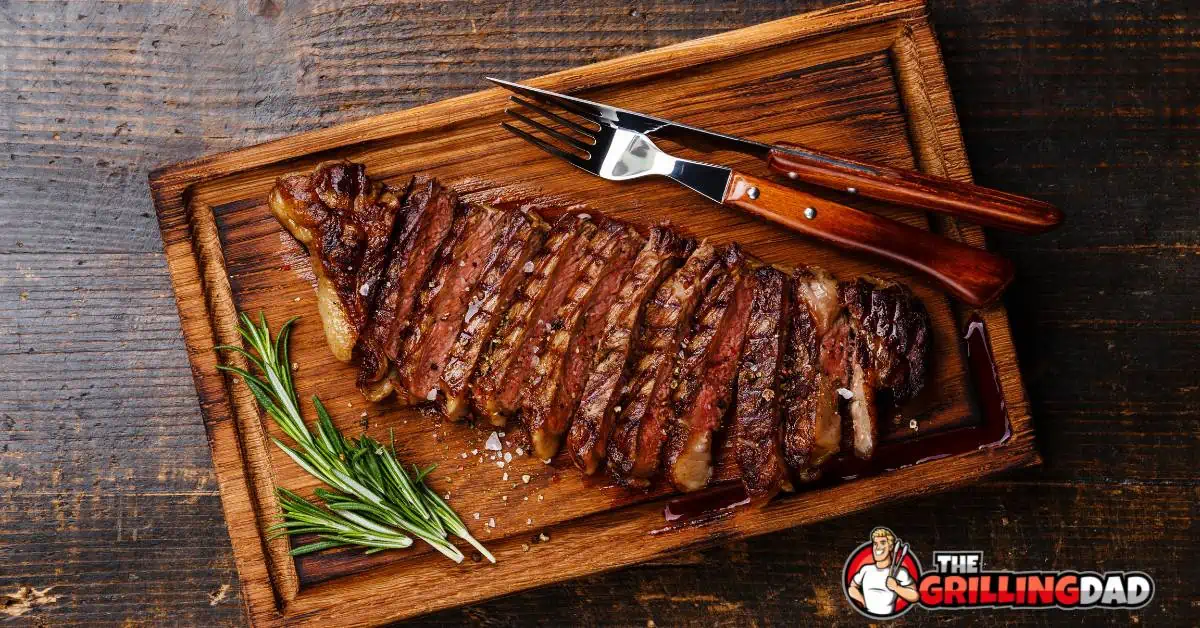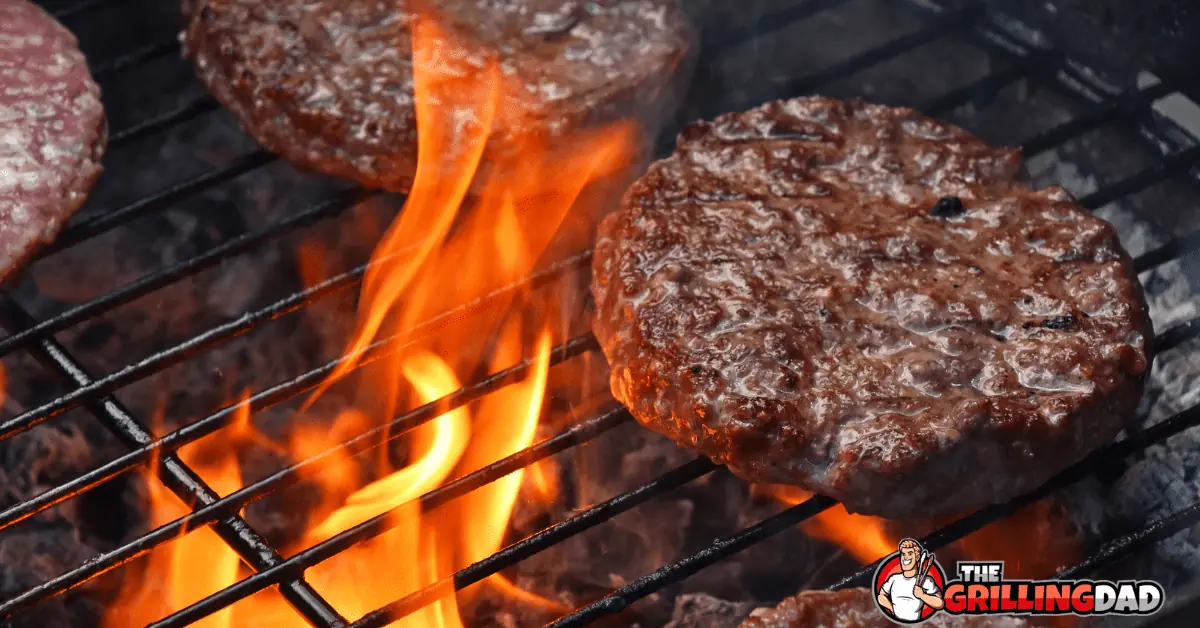Are you tired of going out to fancy restaurants just to get a perfectly grilled steak? Well, it’s time to become a grill master and impress your family and friends with your skills. In this article, we’ll walk you through the steps of grilling a mouthwatering steak on a charcoal grill, so grab your apron and let’s get started!
Jump to Section
How to Grill a Steak on a Charcoal Grill
Whether you’re a chef or just a hobbyist, getting that perfectly juicy and tender steak is an art form. But why should you bother grilling your steak on a charcoal grill when you can use the convenience of a gas grill?
Well, the answer is simple: flavor! Charcoal grilling adds an extra smokiness to the steak that simply can’t be replicated. Not to mention, there is a primal satisfaction that comes from cooking your dinner over a fire that you built.
The best part is grilling the perfect steak is easy to learn. With just a few simple tips and tricks, you can become an expert in charcoal grilling in no time!
Related: Can You Add Charcoal While Grilling?
It Starts With Choosing The Right Steak
Not all cuts of meat are created equal. The old adage, “garbage in, garbage out,” definitely applies here. The art of choosing a steak comes in a few simple steps.
- Stick With The Popular Cuts.
There is no need to get fancy when you’re picking out dinner. A ribeye, New York strip, sirloin or T-bone are always great choices. Plus, they all react in a similar way when heat is applied, so you have a consistent result. - Pick A Good Grade Of Beef
If you’ve ever struggled with how your steaks turn out, odds are it’s the cut of meat, not the cook. If you’re not choosing quality beef, you’re not setting yourself up for success.
Beef is rated for the amount of marbling (the intermuscular fat that runs throughout it) it has. The fat creates the flavor, and the more there is, the better the grade of meat will be. At the very least, go with a “Choice” cut for grilling. If you really want a steakhouse-quality meal, then you need to find a “Select” or “Prime” cut. - TheThicker The Better
Thin steaks cook too quickly, and the odds of getting a medium-rare result are not in your favor. Steaks should be at least one inch thick or better. That will give you enough product to get a good sear and allow you to properly finish the middle.
If you do go with thicker cuts, you will need to adjust some of the times mentioned below. You may also want to sear your steak with the grill cover on to warm the top of the steak that isn’t directly on the coals.
The Basic Requirements
Aside from the steak, here is a short list of what you will need to grill the perfect steak on a charcoal grill.
- A good charcoal grill. There are good and bad in this category, and if you aren’t getting the results you want from your grill, it may be time to consider an upgrade. Just like the quality of your food, the quality of the tools you use to cook it will have a dramatic effect on the result.
- A charcoal chimney or lighters. Charcoal chimneys are a basic need for most grills. It’s a great way to measure the right amount of charcoal you need and an effective method of lighting the coals. Firestarters are made from natural material that is easily lit and will burn long enough to ignite your coals.
Don’t use lighter fluid. Be sure to light your grill naturally so you can avoid having an expensive steak taste like lighter fluid. - A good meat thermometer. Digital, instant-read thermometers are great and inexpensive. There are many types available and having one on hand is the easiest way to know when whatever protein you are cooking is ready to come off the grill and be served.
A Word About Charcoal
It’s not all the same, and the flavor you put into your steak starts with the quality and type of charcoal you use. Charcoal is made by burning wood at extremely high temperatures in a low-oxygen environment that removes the water, methane, and tar from the wood, leaving the carbon. Once it is in that form, it can be sold in two different forms:
Lump Charcoal: This is the more expensive type of charcoal, but it burns hotter and cleaner. It also produces less ash than briquettes, and the ash can then be put into your garden or lawn as a natural fertilizer.
Briquettes: These are made from the same burnt wood as lump charcoal that is crushed and formed into coals with mineral char for higher heat and sawdust to help with ignition. Briquettes are cheaper and can give more consistent heat than lump charcoal. However, the fillers and chemicals that are used in the manufacturing process are less friendly to the environment, leave more ash to clean up and can also leave an odd flavor in your food.
Related >> New York Strip vs. Ribeye: A Comprehensive Comparison
How Much Charcoal To Use
Steaks need a lot of heat, and as a result, you will want a larger amount of charcoal in the grill than you would for hotdogs or burgers. The trick is putting in enough to get the heat you want to get the desired sear and internal temperature without overcooking the steak.
The best way to measure charcoal is to use a charcoal chimney. Usually, a chimney full of charcoal is a good place to start. If the heat is not enough for your grill, add another half of a chimney, and that should give you the heat you desire. So much of grilling is trial and error, my recommendation is to do a test cook or two to see what you need for your grill.
Related >> How Much Charcoal to Use in a Grill
How To Get Great Results Every Time
The best part about grilling steaks is the ease with which you can get a steakhouse-quality meal. All you have to do is follow a few simple steps, and you can be the steak guru of your family.
- Dry Brine The Meat. Rinse the steak and pat it dry. Put it on a rack and put that rack on a baking sheet. Cover it liberally with salt and pepper and leave it uncovered in the refrigerator overnight. This will tenderize the meat and ensure it stays moist while it’s being grilled.
- Warm Up Your Steak. It’s important to bring the meat out of the cold before cooking so it gets closer to room temperature, as this affects how it is cooked. Take your steaks out of the fridge for up to one hour before grilling them so that when they’re cooked, the outside of the meat does not burn, and the inside is at the right temperature.
- Season The Steak. You’ve already got a good amount of salt on it. However, as you set it out to warm up a bit, it’s a good time to add a few extra flavors. I suggest mixing about 2 tablespoons of course-ground pepper, 2 tbsp of granulated garlic, 2 tbsp of granulated onion and 2 tbsp of smoked paprika in a small bowl and liberally sprinkling it over the meat just as it sits on the counter, warming up to room temperature.
- Light The Grill. Use a chimney or fire starter to light the coals in your grill. Avoid using lighter fluid because it adds a poisonous chemical to your fire and it will likely leave a bad flavor in whatever you are grilling. If you’d like more details on the basics of using a charcoal grill, feel free to read How to Grill with Charcoal.
- Arrange The Coals And Preheat The Grill. For steak, you should generally use a two-zone setup. Arrange your lit coals on one side of the lower grate so you have a hot side for searing and a slightly cooler side so you can cook the steak without burning it.
Once the grill is lit and the coals are arranged, all you need to do is give the whole thing time to heat up — at least 15 minutes. You want the hot side to be good and hot so it will sear the meat when the steak hits the grate. - Now It’s Time To Grill. Start on the hot side of the grill to sear your steak. Put it on the grate at an angle (if you want fancy grill marks), and don’t touch it for about 3 minutes. This time may vary, depending on the thickness of your steak, but all you’re doing is getting a good sear on it to lock in the juices. When you hit the 3-minute mark, flip it and let it sit for about 3 more minutes.
That should be enough to cook the steak thoroughly. Check the internal temperature with a digital thermometer if the steak is at 130℉. If it is, take it off the heat and rest it. If it’s not, move it to the off-heat side of the grill to finish. - Rest The Steak. Once the steak comes off the grill, you need to let it rest for about 5 minutes. It will continue cooking and could increase in temperature by as much as 5 more degrees. It will also allow the juices to settle in the middle of the steak and relax the muscle fibers. That way, you get a more tender and juicy steak when you cut into it.
- Slice and serve. Slicing into a steak is an incredibly important part of the process. Use the sharpest knife you can find. A sharp knife will cut cleanly and will preserve the tenderness and juiciness of the meat.
Always slice across the grain. The grain of a steak is the long, parallel muscle fibers in the meat. By cutting those fibers, you remove or reduce any toughness that may still be in the steak, making it as tender as it can be.
Related >> How to Use a Santoku Knife
How To Know If Your Steak Is Done
The easy answer is to use an instant-read thermometer and check the internal temp. The worst way to do this is to cut into the steak and check the middle. When you do that, the juices flow out, and you will end up leaving all of that beefy goodness sizzling in your charcoal.
If you don’t have a thermometer, you can check doneness with one of the most versatile and important tools any chef has in the kitchen — your hands. Using your hand to mimic the “feel” of a steak at various levels of doneness is a quick, easy way to check if the meat is ready to come off the grill.
Open the palm of your hand – if it’s relaxed enough, and then push on the fleshy area at the base of your thumb, just above the wrist. This will give you an idea of how uncooked meat should feel.
If you press your index finger and your thumb together and then push that same area at the base of your thumb, it will have the same feel as a rare steak. Your middle finger pressed against your thumb feels like a medium-rare steak, your ring finger equals medium well, and your pinky pressed against your thumb is the same feel as a well-done steak.
Check your hand, then press on the steak with your tongs. If the steak has the same tension as the finger-to-thumb configuration described above, then you know how done it is.
One Last Piece Of Advice
Don’t be intimidated by the process. This article has a lot of detail to help, but grilling a steak to perfection is a simple and highly rewarding pursuit. The most important thing to remember is to start with a high-quality cut.
The better the product, the more forgiving it will be when you grill it. From there, you just have to grill a few, and yes, make a few mistakes. That’s how we all get better and how you become the grill guru we know you are.





